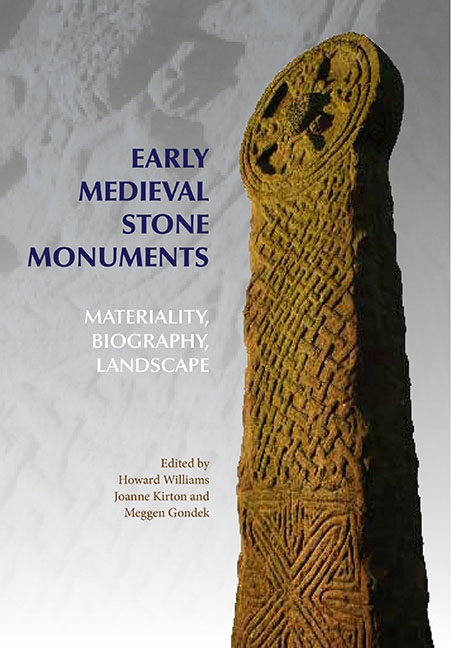Book contents
- Frontmatter
- Dedication
- Contents
- List of Illustrations
- List of Tables
- Acknowledgements
- 1 Introduction: Stones in Substance, Space and Time
- 2 Locating the Cleulow Cross: Materiality, Place and Landscape
- 3 Walking Down Memory Lane: Rune-Stones as Mnemonic Agents in the Landscapes of Late Viking-Age Scandinavia
- 4 Building Blocks: Structural Contexts and Carved Stones in Early Medieval Northern Britain
- 5 Memory, Belief and Identity: Remembering the Dead on Iniscealtra, Co. Clare
- 6 The Biographies and Audiences of Late Viking-Age and Medieval Stone Crosses and Cross-Decorated Stones in Western Norway
- 7 Lifeways in Stone: Memories and Matter-Reality in Early Medieval Sculpture from Scotland
- 8 A Stone in Time: Saving Lost Medieval Memories of Irish Stone Monuments
- 9 Hogbacks: the Materiality of Solid Spaces
- List of Contributors
- Index
8 - A Stone in Time: Saving Lost Medieval Memories of Irish Stone Monuments
Published online by Cambridge University Press: 21 May 2021
- Frontmatter
- Dedication
- Contents
- List of Illustrations
- List of Tables
- Acknowledgements
- 1 Introduction: Stones in Substance, Space and Time
- 2 Locating the Cleulow Cross: Materiality, Place and Landscape
- 3 Walking Down Memory Lane: Rune-Stones as Mnemonic Agents in the Landscapes of Late Viking-Age Scandinavia
- 4 Building Blocks: Structural Contexts and Carved Stones in Early Medieval Northern Britain
- 5 Memory, Belief and Identity: Remembering the Dead on Iniscealtra, Co. Clare
- 6 The Biographies and Audiences of Late Viking-Age and Medieval Stone Crosses and Cross-Decorated Stones in Western Norway
- 7 Lifeways in Stone: Memories and Matter-Reality in Early Medieval Sculpture from Scotland
- 8 A Stone in Time: Saving Lost Medieval Memories of Irish Stone Monuments
- 9 Hogbacks: the Materiality of Solid Spaces
- List of Contributors
- Index
Summary
INTRODUCTION
One of the most frustrating aspects of our encounters with medieval art is our inability ever to know exactly how far our responses, aesthetic, emotional or intellectual, correspond with those of medieval viewers. Such dissatisfaction has, in the past, led scholars to concentrate on the making of monuments and artefacts, rather than their afterlife, as the technical processes of, for instance, filigree working, are more readily extractable from objects such as the Tara Brooch than are its owner's or owners’ sentiments towards it (Whitfield 2001a; 2001b; 2004). Although also prevalent in archaeology, scholarly fixation with the moment of creation is particularly a commonplace of art-historical studies, given the discipline's roots in artistic biography. This is a legacy peculiarly unhelpful for the study of medieval art, where the anonymity of artists is the norm, and even categorization of the creator as artist, not craftsman, is potentially misleading (e.g. Fernie 1995, 10–21). Stylistic analysis, which helps fix that creative moment in time and place, although a useful tool when used with care, has a distressing tendency to eliminate the anonymous artist or craftsman altogether by substituting artistic choice with vague ‘influences’. This scholarly elimination of human actors from the artistic narrative is both alienating and marginalizing, leaving art objects stranded in a depersonalized vacuum, valued largely for their display of technical brilliance and little else. Such artworks, especially those without narrative, or even figurative scenes, may frequently now be perceived as incomprehensible and thus irrelevant not merely by contemporary viewers, but by art historians of other periods, and even by medievalists working in different disciplines.
How can we repopulate this artistic world? It is difficult, although not always impossible, to examine the artist's creative and imaginative role in the making of medieval works (see Heslop 2008). If artistic creativity frequently remains opaque, however, scholars have increasingly begun to acknowledge that reuse and spoliation may allow an often startling insight into the ongoing biography of an object or building after its initial creation: that is, into its reception if not by its contemporaries, by later users and spectators (Kinney 2006; 2011). This paper will attempt to resocialize Irish medieval art by exploring its reception (see Caviness 2006), particularly in terms of continuing interactions with medieval metalwork and stonework by different audiences from the ninth to twelfth centuries.
- Type
- Chapter
- Information
- Early Medieval Stone MonumentsMateriality, Biography, Landscape, pp. 216 - 240Publisher: Boydell & BrewerPrint publication year: 2015
- 1
- Cited by



